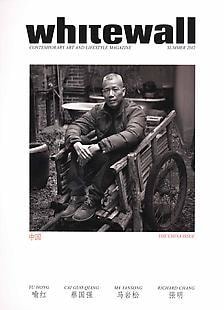
Whitewall
Summer 2012
Liu Wei
By: Jérôme Sans
WHITEWALL: Your work jumps among video, installation, painting, and objects. How do you relate all these things together?
LlU WEI: That's not how I think. I don't begin from a material or a technique and then think about what I want to do. Rather, I have an idea and then think about how to express it. I am always changing what I do; when I get fluent at a certain type of work - for example, the cut pieces or any other series - at a certain point there are no longer any obstacles or problems. At this point, I start to feel like there is no way to go on, precisely because there are no more problems, it is already dead, so I need to change to another sort of feeling. I want to preserve a state of permanent instability; this is the only way to stay active and vital.
WW: What inspires you?
LW: At the very least it is something that causes problems, something I cannot entirely grasp, the feeling that in creating these objects or realizing these ideas there is always an element of terror. After the works are made, these feelings remain unstable, leaving me in a constant state of anxiety. Perhaps there is another way to go about it. Some people really enjoy stability in their creation; they are more than equal to the task, like the old masters, everything well thought-out. But I am not well suited to this way of working - I don't find it sufficiently dynamic.
WW: I see in your work a connection with architecture, from the hutong windows to the dog-chew sculptures of parliament buildings, to the paintings of urban landscapes. So there is this ironic approach, whether it is the dogs chewing on the bones or this cage that hints at an oppressive city with no more room for freedom. What is the relationship to cities?
LW: Cities are reality - all of China is a city under construction, and of course this influences me. You cannot ignore that; you can only ask why it is so. In the end, there are reasons for everything. All of this is about the system, in the end.
WW: What kind of statement is here, when you use elements from vernacular architecture 10 build a meeting room, or when you use bones 10 show the architecture of power?
LW: In this work I was aiming for a special connection between the material and power itself. It is very animal: The human will to power is like a dog seeing a bone, an animal reaction. And the viewer's reaction is very interesting, particularly compared to the effect I was aiming for, because the buildings actually look quite beaten-down, like a ghetto, as if all the political power of the world could be placed in a little slum. But when people see this work, they always say how nice it looks, how pretty the buildings are, and this proves that the artist should never trust his own eye. Actually, the desired effect is similar to the paintings I did of diamonds. Those were really bad paintings of diamonds; if they had been beautifully painted, the work would have been altogether different, because people would have known they were trying to represent diamonds. But no matter how poorly I paint, people always think my works are pretty. This leaves me helpless. Whatever you say is useless - some understandings cannot be changed. This is actually just another reason to make a work like this.
WW: How do you see the future of the Chinese art scene?
LW: I don't know -I have no way of thinking about this question.
WW: Why not?
LW: This question is not in my system.
WW: Which questions are in your system?
LW: It's rather individual, and it grows simpler and simpler as I peel away layers. But I don't think about questions like the future of Chinese art. It's hard because just now I'm trying to get rid of all my old questions, and to get beyond all my old works. I'm doing this sort of work now, peeling away the old. But it's difficult - you can't get rid of them.
Published in the exhibition catalogue "Breaking Forecast" (Ullens Center for Contemporary Art and Timezone 8, 2009).
